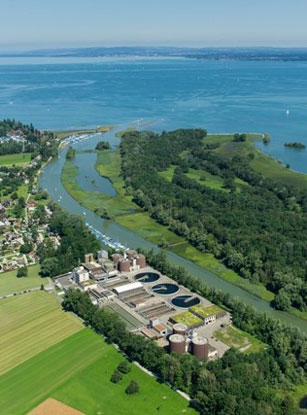
Altenrhein, Switzerland
The WWTP Altenrhein treats municipal and industrial wastewater for 120,000 pe. The process consists of mechanical treatment, primary clarifiers, activated sludge with biological P removal, nitrification and denitrification, and final sand filtration. Sludge is digested on-site together with external sludge from other WWTPs, dewatered and dried, and disposed in a cement kiln. Due to the treatment of external sludge, the sludge dewatering effluent represents a high return load of nitrogen which is recycled to the inlet of the WWTP.
During the POWERSTEP project, a full-scale treatment of this sidestream is realised using the process of membrane ammonia stripping. In this process, nitrogen is transferred in NH3 form from the sludge water via a gas-permeable membrane into sulfuric acid, which can then be sold as nitrogen fertiliser (diammonium sulfate). The membrane stripping process requires a multi-stage pre-treatment of the sludge water to remove any particles and adjust proper conditions for an efficient stripping (high pH and temperature).
-
What purposes?
-
Which approaches?
-
Which technologies?
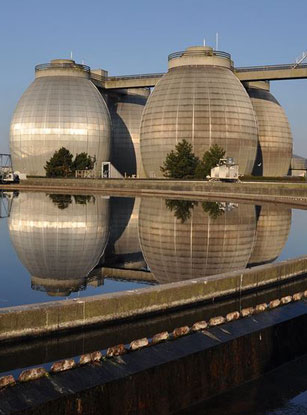
Avedøre, Denmark
The WWTP Avedøre treats municipal wastewater with a maximum capacity of 345,000 pe, mainly for the city of Copenhagen. The process consists of mechanical treatment, primary clarifiers, and activated sludge with biological P removal and nitrification/denitrification. Sludge is digested, dewatered and incinerated on-site, while biogas is used in a gas engine to provide electricity and heat to the plant and for sale to the public grid.
In the POWERSTEP project, a power-to-gas (P2G) plant was operated and optimised to convert residual CO2 in the biogas into biomethane while using renewable electricity from the grid during low prices (e.g. excess supply of wind and PV power). The P2G plant uses an electrolyser to produce H2 gas, which is fed into a biological reactor where special bacteria (archaea) convert H2 and CO2 into CH4. The process can either work directly with biogas (mixture of CH4 and CO2), or on pure CO2 separated from biogas during gas upgrading (e.g. in a scrubber). The produced biomethane is further cleaned prior to injection of the renewable gas into the local gas grid. By-products of the P2G plant are pure oxygen and heat, which can both be utilized on-site at the WWTP.
-
What purposes?
-
Which approaches?
-
Which technologies?
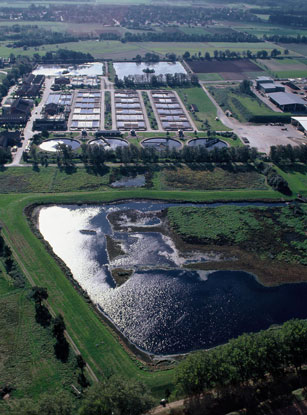
Braunschweig, Germany
The WWTP Braunschweig treats municipal wastewater for 350,000 pe from the city of Braunschweig. The process consists of mechanical treatment, primary clarifiers, and activated sludge with biological P removal and nitrification/denitrification. The secondary effluent is either recycled as irrigation water to agriculture, or discharged via wetlands into the local river. Sludge is digested, dewatered and applied in agriculture, while biogas is valorised in CHP plants for electricity and heat production.
In the POWERSTEP project, two measures for improved energy management were tested at WWTP Braunschweig. The first approach encompassed a desktop study to estimate potential cost savings by applying different strategies for energy management and integration into a “smart grid” (e.g. market price for electricity, optimised operation of CHP, storage of biogas, load shifting, power-to-gas). The second approach tested a “heat-to-power” process in pilot scale where excess heat can be converted into additional electricity, drawing on the available exhaust heat of the CHP units with a thermo-electric generator.
-
What purposes?
-
Which approaches?
-
Which technologies?

Kirchbichl, Austria
The WWTP Kirchbichl treats municipal wastewater for 100,000 pe. The process consists of mechanical treatment and a two-stage activated sludge process with a high-load stage for BOD removal and low-load stage for nitrification. Sludge is digested on-site, dewatered, composted and disposed in agriculture.
In the POWERSTEP project, a separate treatment step for the centrate from sludge dewatering is tested in full-scale to improve the energy balance of the plant. This sludge dewatering effluent is highly loaded with nitrogen, which is normally recycled to the inlet of the WWTP and increases the load and energy demand of the main line. The biological process of nitritation (conversion of ammonia to nitrite) is established for the sidestream, and the formed nitrite is recycled back to the high-load activated sludge tank where the chemically bound oxygen can be utilised by bacteria. Due to the better efficiency of oxygen transfer in the sidestream, this concept saves electricity for aeration and also improves COD extraction into sludge, increasing biogas production.
-
What purposes?
-
Which approaches?
-
Which technologies?
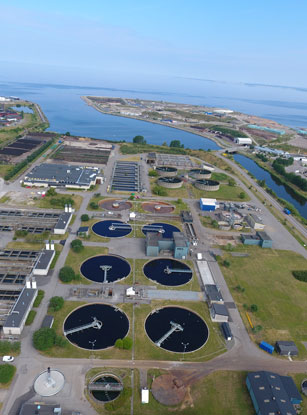
Sjölunda, Sweden
The WWTP at Sjölunda treats municipal and industrial wastewater for 300,000 pe, mainly for the city of Malmö. The process includes mechanical treatment, primary clarifier, a high-load activated sludge process with anaerobic and aerobic parts for BOD removal, and a post-treatment in trickling filters for nitrification and moving bed biofilm reactors (MBBR) for denitrification with external carbon source.
In the POWERSTEP project, a pilot plant for testing of mainstream N treatment via nitritation and anammox was operated after enhanced carbon extraction. The mainstream process was tested in two pilot reactors (50 m3) based on a two-stage configuration (MBBR for nitritation followed by MBBR for anammox) and a one-stage configuration with simultaneous nitritation and anammox, operated in integrated fixed-film activated sludge (IFAS) configuration. Influent for the mainstream anammox was provided either by high-load activated sludge (full-scale) or microscreen with upstream chemical dosing (pilot discfilter with xx µm mesh). Process control with STAR system was used to control the mainstream anammox process.
-
What purposes?
-
Which approaches?
-
Which technologies?
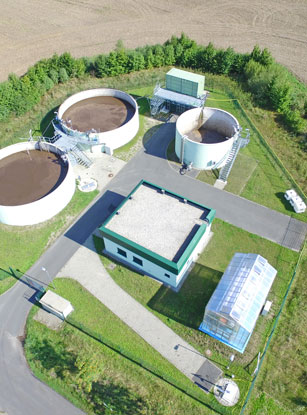
Westewitz, Germany
The WWTP in Westewitz treats municipal wastewater for 2000 pe in a sequencing batch reactor (SBR) process. Built in 2009, its original scheme includes mechanical treatment and two SBR reactors operating with aerobic stabilisation of sewage sludge. Excess sludge is stored in a storage tank on-site and transported to a larger WWTP in regular intervals for dewatering and disposal.
During the POWERSTEP project, the site was equipped with a microscreen (drum filter, 40 µm mesh) as primary treatment in 2016 to enable carbon extraction in form of primary sludge. This pre-treatment reduces influent COD load to the biological process and generates additional sludge for increased biogas production in sludge treatment. Depending on the target for carbon extraction, chemicals such as coagulant (metal salt) and flocculant (polymer) can be dosed upstream of the microscreen to increase COD elimination up to 70%. The WWTP has a discharge limit of 18 mg/L total nitrogen (TN), and an advanced control strategy is installed to provide sufficient COD into the SBRs so that TN levels in the effluent are safely below the limit.
Another process to remove TN without carbon source is tested on-site with a pilot reactor growing duckweed on the effluent of the microscreen. This process should remove nutrients N and P by uptake into duckweed plants floating on the water surface. These plants can then be harvested and used for biogas production.
-
What purposes?
-
Which approaches?
-
Which technologies?